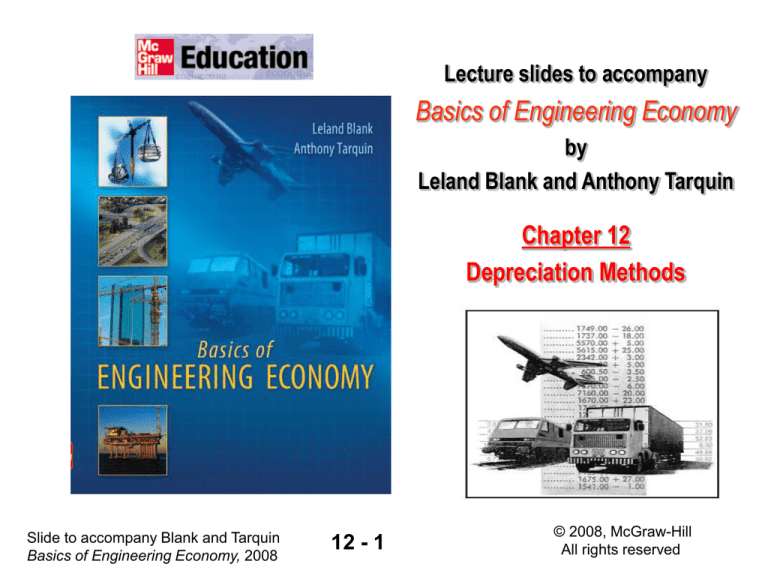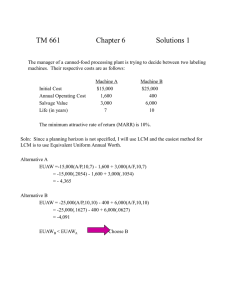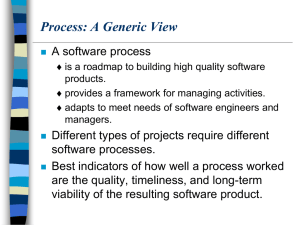
Lecture slides to accompany
Basics of Engineering Economy
by
Leland Blank and Anthony Tarquin
Chapter 12
Depreciation Methods
Slide to accompany Blank and Tarquin
Basics of Engineering Economy, 2008
12 - 1
© 2008, McGraw-Hill
All rights reserved
Chapter 12 – Depreciation Methods
PURPOSE
TOPICS
Use a specific model to
reduce the value of an
asset (by depreciation)
or natural resource (by
depletion)
• Depreciation
terminology
• Straight line
• Declining balance
• MACRS
• Switching models
• Depletion methods
• Spreadsheet usage
Slide to accompany Blank and Tarquin
Basics of Engineering Economy, 2008
12 - 2
© 2008, McGraw-Hill
All rights reserved
Sec 12.1 - Terminology
• Depreciation is the reduction in value of an asset
over time
• Depreciation represents the loss in value due to:
–
–
–
–
Use, and wear and tear on the asset
Deterioration over time
Obsolescence
Technological replacement
• Depreciation represents the diminishing amount
of capital invested in the asset
• Deprecation represents an amount of money
charged against future income produced by the
asset
Slide to accompany Blank and Tarquin
Basics of Engineering Economy, 2008
12 - 3
© 2008, McGraw-Hill
All rights reserved
Sec 12.1 - Terminology
• In most countries, depreciation is a tax
deductible expense. It reduces tax liability for a
corporation
• Unlike other, real expenses, depreciation is
not an actual cash flow amount
Two types of depreciation used by corporations
Book depreciation -- Used internal to the corporation for
financial and accounting purposes
Tax depreciation -- Per government regulations, used in
calculating income taxes due
In an economic analysis, tax depreciation
is usually concentrated upon
Slide to accompany Blank and Tarquin
Basics of Engineering Economy, 2008
12 - 4
© 2008, McGraw-Hill
All rights reserved
Sec 12.1 - Terminology
First cost, B – Total cost of
asset including purchase,
installation, fees, etc.
Salvage, S –
Estimated
market value at
end of recovery
period
BV, $
Book Value, BV –
Remaining,
undepreciated
investment after all
depreciation to date is
removed
S
Time, years
Recovery period, n – Depreciable life in years.
Tax and book depreciation lives often vary
Slide to accompany Blank and Tarquin
Basics of Engineering Economy, 2008
12 - 5
© 2008, McGraw-Hill
All rights reserved
Sec 12.1 - Terminology
Some additional terms to
know
There are two types of
depreciable property
• Depreciation rate, d –
fraction of first cost
removed each year. (Rate
Personal – Incomeproducing, tangible property
of a corporation, e.g.,
vehicles, equipment, etc.
Real – Real estate and its
improvements, such as,
buildings, factories, other
construction
is dt when it varies each year t)
• Half-year convention –
assumes asset is placed
into initial service or
disposed of in midyear,
regardless of when it
actually occurs. (Used in
US-approved tax depreciation
method called MACRS)
Slide to accompany Blank and Tarquin
Basics of Engineering Economy, 2008
12 - 6
Note: Land itself is not
depreciable
© 2008, McGraw-Hill
All rights reserved
Sec 12.1 – Depreciation Methods
Some methods used in the US and
other countries
Straight Line (SL)
Standard against which other
methods are compared
Book value decreases linearly
over time
Declining Balance (DB)
Accelerated write-off compared to
SL method
Defers part of tax liability to later
in recovery period
Modified Accelerated Cost
Recovery System (MACRS)
Required tax depreciation method
in US since 1986
Slide to accompany Blank and Tarquin
Basics of Engineering Economy, 2008
12 - 7
© 2008, McGraw-Hill
All rights reserved
Sec 12.2 – Summary of Notation
B – First cost or basis for depreciation
n – Recovery period in years
S – Estimated salvage value at end of recovery
period
t – year, t = 1, 2, …, n
Dt – Depreciation charge for year t
dt – Depreciation rate for year t (d, if same each
year)
BVt – Book value after t years of depreciation
Slide to accompany Blank and Tarquin
Basics of Engineering Economy, 2008
12 - 8
© 2008, McGraw-Hill
All rights reserved
Sec 12.2 – Straight Line
Example:
First cost is $50,000
with life of 5 years
and estimated
salvage of $10,000
Plot SL book value
Dt = B – S
n
BVt = B - t×Dt
= BVt-1 - Dt
dt = d = 1/n
Excel function to display Dt:
= SLN(B,S,n)
(Used in Sec 12.7)
Slide to accompany Blank and Tarquin
Basics of Engineering Economy, 2008
12 - 9
B = $50,000
S = $10,000
n = 5 years
© 2008, McGraw-Hill
All rights reserved
Sec 12.2 – Straight Line - Example
SL depreciation:
Dt = (50,000-10,000)/5 = $8,000
SL book value: BVt = BVt-1 – Dt
Year, t
Dt
BVt
0
$8,000 $50,000
1
8,000
42,000
2
8,000
34,000
3
8,000
26,000
4
8,000
18,000
5
8,000
10,000
Slide to accompany Blank and Tarquin
Basics of Engineering Economy, 2008
12 - 10
© 2008, McGraw-Hill
All rights reserved
Sec 12.3 – Declining Balance (DB)
• DB write-off of asset value is accelerated
compared to SL
• Larger annual depreciation amounts in the early
years of recovery period
• Also called fixed percentage or uniform
percentage method
• Annual depreciation Dt equals book value at
beginning of year BVt-1 (which is same as end of
previous year) times fixed rate d
Dt = d × BVt-1
Slide to accompany Blank and Tarquin
Basics of Engineering Economy, 2008
12 - 11
© 2008, McGraw-Hill
All rights reserved
Sec 12.3 – Declining Balance
Values of d are related to SL depreciation rate
2 times SL rate: d = 2/n
This is dMAX and is largest allowed by law
If n = 5, dMAX = 2/n = 0.4
40% of BV is removed each year
Known as double declining balance (DDB)
150% of SL rate: d = 1.5/n
If d is 100% of SL rate, d = 1/n, which is SL depreciation
Notation reminder:
d is the fixed percentage of BV removed each year
dt is the depreciation rate for each year t
Slide to accompany Blank and Tarquin
Basics of Engineering Economy, 2008
12 - 12
© 2008, McGraw-Hill
All rights reserved
Sec 12.3 – Declining Balance
Annual depreciation determined in either of 2 ways
• Using book value of previous year
Dt = d × BVt-1
• Using first cost basis B
Dt = dB(1-d )t-1
Annual book value determined in either of 2 ways
Using first cost basis B
BVt = B(1-d )t
Using sum of accumulated depreciation for years i=1 to t
BVt = B – ΣDi
Slide to accompany Blank and Tarquin
Basics of Engineering Economy, 2008
12 - 13
© 2008, McGraw-Hill
All rights reserved
Sec 12.3 – Declining Balance
Characteristic book value plots of SL, DB and DDB
SL depreciation
DB depreciation
at 150% SL rate
DDB depreciation
Slide to accompany Blank and Tarquin
Basics of Engineering Economy, 2008
12 - 14
© 2008, McGraw-Hill
All rights reserved
Sec 12.3 – Declining Balance
Annual depreciation rate for each year t, relative
to first cost B, is
dt = d(1-d)t-1
Salvage value is not used in DB method formulas
Implied salvage is book value in year n
Implied S = BVn = B(1-d)n
If a salvage value is estimated, and estimated S >
implied S, stop depreciating whenever expected S
value is reached
Slide to accompany Blank and Tarquin
Basics of Engineering Economy, 2008
12 - 15
© 2008, McGraw-Hill
All rights reserved
Sec 12.3 – Declining Balance Example
P = $80,000
S = $10,000
n = 5 years
Compare BV values for two methods:
cont →
DDB and DB at 150% SL rate
DB rate is d=1.5/5 = 0.3 DDB rate is dMAX=2/5 = 0.4
Slide to accompany Blank and Tarquin
Basics of Engineering Economy, 2008
12 - 16
© 2008, McGraw-Hill
All rights reserved
Sec 12.3 – Declining Balance Example
• Neither method used the estimated S of $10,000
to calculate Dt or BVt, except …
• For DDB, depreciation in year 5 is limited, since
BV5 would go below S = $10,000
• Only a $368 write-off is allowed in year 5, which
is much less than the calculated amount of
D5 = d(BV4) = 0.4(10,368) = $4,147
cont →
Note: For the only US-government approved depreciation
method, MACRS (covered next), the estimated S is not
used since the entire first cost B is always depreciated to zero
Slide to accompany Blank and Tarquin
Basics of Engineering Economy, 2008
12 - 17
© 2008, McGraw-Hill
All rights reserved
Sec 12.3 – Declining Balance Example
Slide to accompany Blank and Tarquin
Basics of Engineering Economy, 2008
12 - 18
© 2008, McGraw-Hill
All rights reserved
Sec 12.4 - MACRS
MACRS became the only allowed tax
depreciation method in the US in 1986
Statutory depreciation rates dt are tabulated
Rates are derived using the DDB or DB method
initially with a switch to SL at the optimal time
Recovery period n is prescribed and tabulated
by asset types
MACRS incorporates the half-year convention
into the rates and recovery period
Slide to accompany Blank and Tarquin
Basics of Engineering Economy, 2008
12 - 19
© 2008, McGraw-Hill
All rights reserved
Sec 12.4 - MACRS
‡ Personal Property -- Recovery periods are set at 3, 5,
7, 10, 15 and 20 years
‡ For n = 3, 5, 7, and 10 -- Depreciation rates start with
DDB method, and switch to SL rates to ensure faster
write-off of B
‡ For n = 15 and 20 -- Depreciation rates start with 150%
DB method, and switch to SL rates to ensure faster
write-off of B
Half-year convention -- Built in to allow only 50% of
first year depreciation; leftover amount is removed in
year n+1 (This removes some of the advantage of accelerated
depreciation)
Slide to accompany Blank and Tarquin
Basics of Engineering Economy, 2008
12 - 20
© 2008, McGraw-Hill
All rights reserved
Sec 12.4 – MACRS Rates – Personal Property
Slide to accompany Blank and Tarquin
Basics of Engineering Economy, 2008
12 - 21
© 2008, McGraw-Hill
All rights reserved
Sec 12.4 – MACRS Rates – Real Property
o Real property includes buildings and permanent
improvements (not land)
o MACRS rates utilize SL method for n = 39 years
with half-year convention built in
o Depreciation rates in % are:
Slide to accompany Blank and Tarquin
Basics of Engineering Economy, 2008
12 - 22
© 2008, McGraw-Hill
All rights reserved
Sec 12.4 – MACRS - Example 1
Use MACRS to depreciate asset with
B = $400,000 and n = 3 years
Year,
t
0
1
2
3
4
Totals
MACRS rate, Depreciation, Book value,
dt
Dt = rate × B BVt=BVt-1 - Dt
$400,000
0.3333
$133,320
266,680
0.4445
177,800
88,880
0.1481
59,240
29,640
0.0741
29,640
0
$400,000
Slide to accompany Blank and Tarquin
Basics of Engineering Economy, 2008
12 - 23
© 2008, McGraw-Hill
All rights reserved
Sec 12.4 – MACRS - Example 2
cont →
Compare MACRS tax depreciation with DDB book
depreciation for B = $400,000 and n = 3 years
Slide to accompany Blank and Tarquin
Basics of Engineering Economy, 2008
12 - 24
© 2008, McGraw-Hill
All rights reserved
Sec 12.4 – MACRS – Example 2
Observations about MACRS and DDB methods
►MACRS always depreciates to
$0; no S considered
► MACRS depreciation in year 1 is
½ the DDB or DB amount
due to implicit half-year
convention
► MACRS takes one additional
year for write-off due to
implicit half-year convention
► DDB method depreciates to an
implied S value at end of the
recovery period
Slide to accompany Blank and Tarquin
Basics of Engineering Economy, 2008
12 - 25
►Book value curves
vary between the
two methods
Book value,
$ 400,000
300,000
200,000
100,000
0
0
DDB
1
2
Year
3
MACRS
© 2008, McGraw-Hill
All rights reserved
4
Sec 12.4 – MACRS
Recovery periods for MACRS
Two methods – GDS and ADS
GDS (General Depreciation System)
Used for most assets
Tabulates MACRS-allowed years for different types of
assets
Recovery ranges from 3 to 39 years; 7 years is default
ADS (Alternative Depreciation System)
Uses SL depreciation instead of MACRS rates
Recovery period is longer than for GDS
Removes early-life tax advantage of MACRS rates
Good for start-up businesses with lower annual
revenues
Slide to accompany Blank and Tarquin
Basics of Engineering Economy, 2008
12 - 26
© 2008, McGraw-Hill
All rights reserved
Sec 12.5 – Switching Methods
• MACRS has imbedded switching from DDB or
150% DB to SL rates to improve the tax
advantage, but half-year convention removes
some of the advantage
• Objective of switching is to
Maximize PW of total depreciation
• Maximizing PWD will minimize PW of taxes paid
over entire recovery period
Slide to accompany Blank and Tarquin
Basics of Engineering Economy, 2008
12 - 27
© 2008, McGraw-Hill
All rights reserved
Sec 12.5 – Switching Methods
General rules for switching between two methods
Usually, DB method to the SL method works best
1.
2.
3.
Switch to new method in year that new Dt exceeds
old Dt
Can switch only one time during recovery period
Never depreciate below estimated S, if there is one
(not a problem for MACRS, since all of B is removed)
4.
Whenever no switch is made, the BV is used as the
basis for next year’s depreciation calculation
Note: MACRS uses these rules to determine the annual
rates, with the half-year convention imposed in years
1 and n+1
Slide to accompany Blank and Tarquin
Basics of Engineering Economy, 2008
12 - 28
© 2008, McGraw-Hill
All rights reserved
Sec 12.5 – Switching Methods
Procedure to switch from DDB to SL
Slide to accompany Blank and Tarquin
Basics of Engineering Economy, 2008
12 - 29
© 2008, McGraw-Hill
All rights reserved
Sec 12.5 – Switching Methods - Example
B = $100,000
n = 5 years
i = 15%/year
Apply DDB-to-SL switching and determine PWD
cont →
t = 1: DDB d = 2/5 = 0.4
DDDB = $40,000
SL d = 1/5 = 0.2
DSL = $20,000
Select $40,000
New B = $60,000
t = 2: DDB d = 2/5 = 0.4
DDDB = $24,000
SL d = 1/4 = 0.25
DSL = $15,000
Select $24,000
New B = $36,000
Slide to accompany Blank and Tarquin
Basics of Engineering Economy, 2008
12 - 30
© 2008, McGraw-Hill
All rights reserved
Sec 12.5 – Switching Methods - Example
PW of depreciation at i = 15% is $73,943
Slide to accompany Blank and Tarquin
Basics of Engineering Economy, 2008
12 - 31
© 2008, McGraw-Hill
All rights reserved
Sec 12.6 – Depletion
• Depreciation is applied to assets that can be
replaced – computers, machines, etc.
• Depletion applies to natural resources not easily
replaced, such as
– Forests (timber)
– Geothermal deposits
– Mineral deposits and quarries (gold and other ores,
gravel, copper, zinc, etc.)
– Oil and gas wells
Two methods of depletion
Percentage depletion
Cost depletion
Slide to accompany Blank and Tarquin
Basics of Engineering Economy, 2008
12 - 32
© 2008, McGraw-Hill
All rights reserved
Sec 12.6 – Percentage Depletion
This method is a special consideration for
natural resources
A constant stated percentage of the resource’s
gross income (GI) may be depleted each year,
provided it does not exceed 50% of the firm’s
taxable income
Annually calculate the depletion using
Percentage depletion = allowed % × GI
Percentage depletions rates are tabulated
Total depletion may exceed first cost of resource
Slide to accompany Blank and Tarquin
Basics of Engineering Economy, 2008
12 - 33
© 2008, McGraw-Hill
All rights reserved
Sec 12.6 – Percentage Depletion
Annual percentage depletion allowances
Example: Gold mine with
GI = $8 M for years 1-5
GI = $5 M thereafter
Years 1-5: Depletion is
0.15(8 M) = $1.2 M
Years 6+: Depletion is
0.15(5 M) = $750,000
Note: This assumes that no
annual depletion > 50% of TI
Slide to accompany Blank and Tarquin
Basics of Engineering Economy, 2008
12 - 34
© 2008, McGraw-Hill
All rights reserved
Sec 12.6 – Cost Depletion
•
•
•
•
•
Annual depletion based on level of activity or
usage of natural resource
Initially calculate the depletion factor pt
Annual depletion = pt × annual activity level
Total depletion can not exceed first cost of
resource
If resource capacity changes (through
reassessment), new pt is determined
Slide to accompany Blank and Tarquin
Basics of Engineering Economy, 2008
12 - 35
© 2008, McGraw-Hill
All rights reserved
Sec 12.6 – Cost Depletion - Example
$700,000 purchased timber cutting rights for an estimated
350 M board-feet. Determine first 2 years depletion if 15 M
and 22 M board-feet are harvested
pt = 700,000/350 = $2,000/M board-feet
Year 1: Depletion = 2,000(15) = $30,000
Year 2: Depletion = 2,000(22) = $44,000
After 2 years, reassessment due to pine bark beetle
damage estimates remaining timber at only 250 M boardfeet, find new pt
New pt = (700,000-74,000)/250 = $2,504/M board-feet
Slide to accompany Blank and Tarquin
Basics of Engineering Economy, 2008
12 - 36
© 2008, McGraw-Hill
All rights reserved
Sec 12.7 – Spreadsheet Usage
Excel functions used for depreciation calculations
Straight Line
Same value each year
SLN(P,S,n)
Double Declining Balance
DDB(P,S,n,t,d)
Different value each year t
Fixed rate d is between 1 and 2
Rate entry is optional; assumed 2 for DDB, if omitted
Rate of 1.5 used for 150% DB method
Slide to accompany Blank and Tarquin
Basics of Engineering Economy, 2008
12 - 37
© 2008, McGraw-Hill
All rights reserved
Sec 12.7 – Spreadsheet Usage
Excel functions used for depreciation calculations
MACRS
VDB(P,0,n,MAX(0,t-1.5),MIN(n,t-0.5),d)
There is no Excel function to calculate MACRS directly
Salvage value entered as zero
MAX and MIN functions replace start and end periods in VDB
Rate d is entered as 2 (DDB) for MACRS recovery periods
of n = 3, 5, 7, and 10
Rate d is entered as 1.5 (150% DB) for MACRS recovery periods
of n = 15 and 20
Switching
VDB(P,S,n,start_pd,end_pd,d)
Switch from DB to SL to maximize PW of depreciation
Optional rate d is between 1 and 2; DDB assumed, if omitted
Start_pd and end_pd are always one year apart
Slide to accompany Blank and Tarquin
Basics of Engineering Economy, 2008
12 - 38
© 2008, McGraw-Hill
All rights reserved
Sec 12.7 – Spreadsheet Usage
B = $500,000
S = $5,000
Straight Line function:
Slide to accompany Blank and Tarquin
Basics of Engineering Economy, 2008
12 - 39
n = 5 years
=SLN(500000,5000,5)
© 2008, McGraw-Hill
All rights reserved
Sec 12.7 – Spreadsheet Usage
B = $500,000
S = $5,000
150% DB function:
Slide to accompany Blank and Tarquin
Basics of Engineering Economy, 2008
n = 5 years
=DDB(500000,5000,5,t,1.5)
12 - 40
© 2008, McGraw-Hill
All rights reserved
Sec 12.7 – Spreadsheet Usage
B = $500,000
S = $5,000
DDB function:
Slide to accompany Blank and Tarquin
Basics of Engineering Economy, 2008
n = 5 years
=DDB(500000,5000,5,t,2)
12 - 41
© 2008, McGraw-Hill
All rights reserved
Sec 12.7 – Spreadsheet Usage
B = $500,000
S = $5,000
n = 5 years
MACRS function:
= VDB(500000,0,5,MAX(0,t-1.5),MIN(5,t-0.5),2)
Slide to accompany Blank and Tarquin
Basics of Engineering Economy, 2008
12 - 42
© 2008, McGraw-Hill
All rights reserved
Sec 12.7 – Spreadsheet Usage
B = $500,000
S = $5,000
DDB-to-SL switch function:
Slide to accompany Blank and Tarquin
Basics of Engineering Economy, 2008
n = 5 years
= VDB(500000,5000,5,t,t+1)
12 - 43
© 2008, McGraw-Hill
All rights reserved
Sec 12.7 – Spreadsheet Usage
Table and graph of BV for depreciation methods
Slide to accompany Blank and Tarquin
Basics of Engineering Economy, 2008
12 - 44
© 2008, McGraw-Hill
All rights reserved







